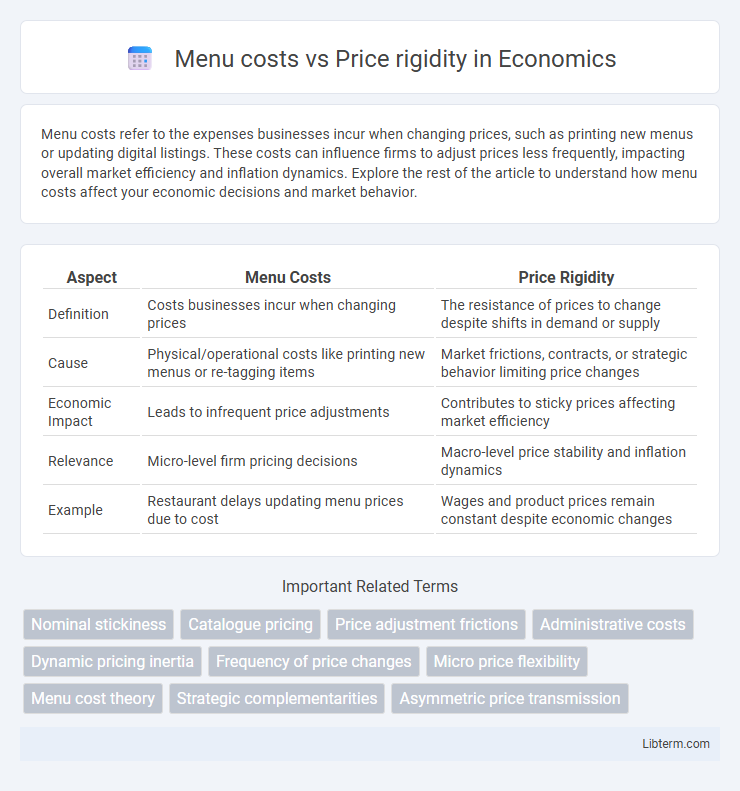Menu costs refer to the expenses businesses incur when changing prices, such as printing new menus or updating digital listings. These costs can influence firms to adjust prices less frequently, impacting overall market efficiency and inflation dynamics. Explore the rest of the article to understand how menu costs affect your economic decisions and market behavior.
Table of Comparison
| Aspect | Menu Costs | Price Rigidity |
|---|---|---|
| Definition | Costs businesses incur when changing prices | The resistance of prices to change despite shifts in demand or supply |
| Cause | Physical/operational costs like printing new menus or re-tagging items | Market frictions, contracts, or strategic behavior limiting price changes |
| Economic Impact | Leads to infrequent price adjustments | Contributes to sticky prices affecting market efficiency |
| Relevance | Micro-level firm pricing decisions | Macro-level price stability and inflation dynamics |
| Example | Restaurant delays updating menu prices due to cost | Wages and product prices remain constant despite economic changes |
Understanding Menu Costs
Menu costs represent the tangible and intangible expenses businesses face when changing prices, such as reprinting menus, updating computer systems, or informing customers. These costs contribute significantly to price rigidity, as firms may avoid frequent adjustments to minimize disruptions and maintain customer loyalty. Understanding menu costs clarifies why prices often remain sticky despite fluctuating market conditions and demand shifts.
Defining Price Rigidity
Price rigidity refers to the resistance of prices to change despite shifts in supply, demand, or cost conditions, often leading to sticky prices in markets. Menu costs are the expenses firms incur when changing prices, such as reprinting menus or updating systems, which can contribute to price rigidity by discouraging frequent adjustments. Understanding price rigidity is crucial for analyzing inflation persistence and market inefficiencies in both microeconomic and macroeconomic contexts.
Causes of Menu Costs in Markets
Menu costs arise from the expenses businesses incur when changing prices, including printing new menus, updating digital systems, and informing customers, which leads to price rigidity in markets. These costs discourage frequent price adjustments despite changes in demand or production costs, causing firms to maintain stable prices even when economic conditions shift. High menu costs are particularly significant in markets with numerous differentiated products, complex pricing strategies, and customer sensitivity to frequent price changes.
Factors Contributing to Price Rigidity
Menu costs, which include expenses related to changing prices such as printing new menus or updating systems, significantly contribute to price rigidity by discouraging frequent adjustments in response to market fluctuations. Firms often face information costs and customer backlash, further reinforcing reluctance to alter prices despite economic shifts. Moreover, contractual obligations and coordination problems within industries exacerbate price stickiness, maintaining stability in prices despite underlying cost changes.
Menu Costs and Consumer Behavior
Menu costs refer to the expenses businesses incur when changing prices, such as reprinting menus or updating digital interfaces, which can deter frequent price adjustments. Consumer behavior plays a significant role as customers may perceive frequent price changes negatively, impacting brand loyalty and purchasing decisions. Firms often maintain price rigidity to avoid these menu costs and to provide stable pricing signals that foster consumer trust and predictability in the market.
Price Rigidity Across Economic Sectors
Price rigidity varies significantly across economic sectors, with services and retail often exhibiting higher price stickiness due to menu costs, long-term contracts, and customer relationship considerations. Manufacturing sectors tend to adjust prices more frequently in response to input cost fluctuations and competitive pressures, minimizing price rigidity. Empirical studies highlight that sectors characterized by high fixed costs and less frequent transactions demonstrate greater resistance to price changes even amid economic shifts.
Real-World Examples of Menu Costs
Menu costs refer to the expenses businesses incur when changing prices, such as printing new menus or updating online listings, which often lead to price rigidity despite market fluctuations. Real-world examples include restaurants avoiding frequent price updates due to printing and design costs, and retail stores delaying price changes to minimize labor and operational disruptions. These costs contribute to slow adjustments in prices, impacting overall market efficiency.
Impacts of Price Rigidity on Inflation
Price rigidity, characterized by slow adjustments to prices despite changing economic conditions, intensifies inflation persistence by preventing swift market corrections. Menu costs, the expenses incurred when businesses change prices, contribute to this rigidity, leading firms to maintain prices even as inflation rises. This stickiness in pricing slows the realignment of supply and demand, causing prolonged inflationary periods and complicating monetary policy effectiveness.
Comparing Menu Costs and Price Rigidity
Menu costs refer to the explicit and implicit expenses businesses incur when changing prices, such as printing new menus or updating systems, which can discourage frequent price adjustments. Price rigidity denotes the resistance of prices to change in response to market conditions, often caused by menu costs, contracts, or customer expectations. Comparing the two, menu costs are a specific cause of price rigidity, as higher menu costs increase price stickiness, limiting firms' ability to adjust prices efficiently in dynamic markets.
Policy Implications for Businesses and Economies
Menu costs, the expenses firms incur when changing prices, contribute significantly to price rigidity, which hinders swift market adjustments in response to economic shocks. Persistent price rigidity can lead to inefficient resource allocation and reduced competitive dynamics, impacting business profitability and economic growth. Policymakers should consider reducing regulatory burdens and promoting flexible pricing strategies to mitigate menu costs, enhance price responsiveness, and support overall economic stability.
Menu costs Infographic

 libterm.com
libterm.com